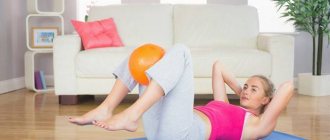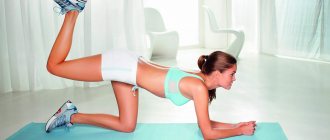A properly selected set of physical exercises for home is an excellent alternative to systematic trips to the gym. After all, everyone wants to look good and have a spectacular figure. However, not everyone manages to go to the gym regularly. A constant lack of time, financial difficulties or other obstacles become the main reasons why many give up sports, and in vain. If you properly develop a training regimen and purchase a few simple sports equipment, home exercises will prove to be very effective.
The benefits of gymnastics for adults
Individual or group gymnastics is not only a fashionable trend in fitness, but also an interesting way to spend time together for a group of friends or colleagues.
Gymnastic exercises:
- accelerate metabolism, stimulate the body’s immune system, as a result of which a person loses extra pounds, strengthens the immune system - less likely to suffer from colds and viral diseases;
- “unload” the brain and increase performance. Gymnastics classes for beginners are low-intensity, so they are recommended by doctors as a means of combating stress, chronic fatigue, and depression. Regular training increases the production of “joy hormones” - serotonin and dopamine, the concentration of which directly affects the feeling of fatigue;
- increase sexuality - due to the normalization of blood circulation, women and men experience an increase in libido;
- strengthen the cardiovascular system, normalize blood pressure, reduce the risk of blood stagnation and the appearance of varicose veins;
- stimulate the lymphatic drainage system, help the body cleanse itself of harmful accumulations and toxins;
- solve sleep problems.
The gymnastics club is a place for new meetings and acquaintances. By signing up for gymnastics, a person joins a community of people who are equally passionate about sports, for whom movement is life.
In order for gymnastics to be beneficial, you must practice under the supervision of a trainer, follow the technique of performing the exercises, and also do not neglect stretching before and after exercise.
General developmental gymnastics
General gymnastics is a common type of physical activity. There is no bet on results or records; all classes are aimed at developing a person’s physical capabilities, improving health, and increasing muscle tone. The training complex is based on basic fitness exercises that, when performed correctly, do not injure joints and tendons.
The general gymnastics section is especially useful for people with problems with the cardiovascular system and musculoskeletal system. It is recommended to use individual exercises from the training cycle as a set of morning exercises to awaken the body and get a boost of energy for the whole day.
General gymnastics also acts as preparatory measures for heavy loads: it warms up the muscles, accelerates the blood, develops ligaments, and improves joint mobility. More information about this type of physical activity can be found in the SOYUZ club, where group and individual classes in general developmental gymnastics are held.
Strength gymnastics
Strength gymnastics involves exercises with weights to create additional resistance to the muscles. Today, both men and women choose this type of fitness. Regular training allows you to build muscle mass, remove fat deposits, tighten and improve body contours.
Each lesson consists of three stages:
- warm-up, with cardio exercises to warm up muscles and joints, preparing the body for stress;
- strength exercises - for beginners, your own weight is often enough;
- stretching exercises.
You can do strength gymnastics at home, but at the first stage it is better to join a sports club to master basic exercises under the supervision of a trainer. He will monitor your body position, draw up a training program, and select a load in accordance with your level of physical fitness.
For those who are bored with lifting weights, we recommend paying attention to CrossFit. The SOYUZ club employs professionals in this area, so you can easily get detailed advice, see the strength training of champions and be able to decide whether strength gymnastics is right for you or not.
Gymnastics
It should be understood that rhythmic gymnastics for adults is one of the types of fitness training, and not a serious application for Olympic records. All exercises are performed in a limited amplitude and do not require super preparation from childhood.
When choosing a gym and trainer, be sure to attend 1-2 classes as an observer. You will appreciate the future mentor's working style, atmosphere, as well as the required level of physical fitness.
As a rule, women come to training who want to discover new capabilities of their body, improve flexibility and coordination of movements, and develop a sense of rhythm. Exercises with additional equipment (balls, ribbons, jump ropes, mace) add variety, help you gain a regal posture, strengthen muscles, and remove fat deposits.
Acrobatic gymnastics
In many ways it has something in common with artistic gymnastics - jumps, steps, and dance steps are also perfected here. People often sign up for training sessions with friends and colleagues - working together strengthens social connections and interpersonal trust, helps to loosen up and gain a sense of leverage.
Modern gymnastics is multifaceted: you can become seriously interested in acrobatics, train in a group, receive ranks and perform in competitions. Or you can simply study individual elements for yourself, surprise your loved ones with success and enjoy small victories.
Health Benefits of Exercise
Today it is hardly possible to find a person who would believe that health-improving exercises are a useless way to spend time. After all, it gives you the opportunity to improve your own body, work on coordination, improve endurance and functioning of the nervous system, and also remove toxins and waste from the body.
It is important to understand that health-improving gymnastics will bring tangible results, provided that the classes are regular. If you regularly perform gymnastics exercises, a person’s posture straightens. This note is especially relevant for those who work in an office. After all, these are the people who spend almost all their time in a sitting position.
When a person makes a firm decision to engage in sports, health-improving gymnastics should begin with drawing up an individual exercise plan that would take into account the characteristics of the body. At the same time, gymnastics for beginners at home should include minimal physical activity. And only after a person understands that the existing workout has become very easy for him, can he begin more severe physical activity.
It will not be possible to achieve any positive effect if health-improving exercises are performed with all diligence, but without regularity. Even just half an hour, but regular exercise, and health exercises will bear fruit in the form of an improved physical and psycho-emotional state. And after a certain period of time, exercises at home will become an integral part of a person’s life.
Regular exercise at home will allow a physically unprepared person to feel stronger muscles. And this result can motivate a person to continue training further. Systematic exercises for health make it possible to eliminate deficiencies in the physique, which means, for example, straightening your posture or losing excess weight.
It is worth remembering that a set of gymnastic movements for beginners is mostly intended to help overcome some motor tasks, control your body, feel and control it better. To achieve these results, many people start running or cycling. However, before you start training in this way, you should perform a number of gymnastic exercises.
If we talk about why gymnastics is needed, we cannot help but note that through it a large number of people were able to eliminate the problem of excess weight. The great advantage of gymnastics training is that it can be done at any time and anywhere. People train at home, in a park near their home, etc. And exercise for the body, regardless of place and time, allows you to solve a large number of health problems. Overall, everyone needs exercise to feel and be healthy.
Where to start classes?
Modern people often do not have enough time to go to the gym, so a large number of people stop at home exercises. In order for gymnastics for beginners to be fruitful and become a habit, you need to remember a few recommendations:
- You need to develop the habit of waking up 15 minutes earlier than usual. This is necessary so that the lesson has a normal pace, because no one wants to reduce the usual time allotted for hygiene, eating and cosmetic procedures.
- As soon as a person wakes up from sleep, he should not jump out of bed. First you need to do a couple of breathing exercises and self-massage. All this will help you recover faster after sleep and cheer up.
- You need to choose exercises that will correspond to the degree of training and the general condition of the body. Perhaps a person suffers from some kind of disease, in this case, before starting classes, you need to consult with your doctor.
- The number of repetitions of exercises should be selected individually. The same applies to the rhythm of movements.
- The load should be increased gradually. If discomfort or shortness of breath appears, you need to stop doing the exercise or reduce the load.
- Gymnastics for beginners must include exercises in which the load is evenly distributed to all parts of the body so that all muscle groups are involved.
- When doing gymnastics, you need to monitor your breathing. It should be uniform and deep. This will allow the muscles to be fully saturated with oxygen.
- It is best to exercise in special comfortable clothing that does not restrict movement. It is better if the training suit is made of cotton fabric.
- If possible, it is preferable to do gymnastics in the fresh air. As a last resort, you can open the window.
- It is best to do gymnastics while listening to fast and rhythmic music. This will allow you to tune in to a positive mood.
- After training, it is recommended to take a shower.
- During the day, you should try to do at least a few exercises that will help relieve stress.
- Walking is a must every day. In this case, you should perform special breathing exercises.
- If a person has already started doing gymnastics for beginners, then one should not stop training under any circumstances. The only exception is a very high temperature or a serious illness.
Gymnastics for everyone: exercises, secrets of nutrition and daily routine for people from 3 to 80 years old
Healthy lifestyle trends today are an obvious fact. Perhaps every active and modern person does fitness, exercises, and practices strength training. It is almost impossible to imagine a city park without charming ladies of an elegant age doing Nordic walking. For young mothers, not supplementing a child’s visits to kindergarten or school with activities in sports clubs is almost considered bad manners.
What about artistic gymnastics? After all, this sport is very productive for the muscular system, strengthening health and immunity. At the same time, you should not immediately imagine sports equipment (rings, parallel bars and logs). Artistic gymnastics is very multifaceted and is aimed at people of different generations.
Today, Olympic medalist, two-time world vice-champion Anton Golotsutskov told us about the benefits of artistic gymnastics and sports in general, the secrets of nutrition and daily routine.
Golotskov Anton Sergeevich,
Russian gymnast, two-time bronze medalist of the Summer Olympic Games in Beijing, two-time vice-World champion, five-time European champion, multiple champion of Russia, multiple winner of the Russian Cup in floor exercise and vault. Founder of the Academy of Artistic Gymnastics in Moscow
First, warm up: from simple to easy
If you decide to take up gymnastics, then the first thing you should think about is a quality warm-up.
You shouldn’t immediately direct your energy to conquering sports equipment. You need to start small so as not to injure your body.
The key to the success of any workout is warming up. I recommend starting with breathing exercises and squats. Everyone’s favorite “bar” “collects” the body very well. Despite its apparent simplicity, this is one of the most difficult exercises with which perhaps every professional athlete begins training. Standing in the plank for more than a minute is aerobatics for a beginner.
I also recommend doing push-ups and abdominal exercises. Pull-ups can be difficult for a beginner gymnastics enthusiast, but it’s worth trying to at least “hint” the muscles that a pull-up is necessary. You should fix the position on the horizontal bar and try to pull your body up gradually and without jerking.
View this publication on Instagram
Publication from Golotsutskov Anton Sergeevich (@anton_golotsutskov) Sep 21, 2021 at 8:04 PDT
Regular running is extremely useful for setting up the body for further work. For this, a park and an early rise are enough.
Adding assistants: jump rope, expander, fitness rubber
If you want to include sports equipment in your training, then you should not neglect such sports assistants for gymnasts as a classic jump rope, expander, and fitness rubber. These are very affordable and very useful sports accessories. It is best to do several approaches, gradually increasing their number. The main advantage is that all muscle groups are worked, although you may not notice it.
A jump rope, for example, should not be treated as a children's accessory for fun games in the yard. This is a very serious sports aid, which is used even by professional boxers. It incredibly develops coordination of movement and concentration. I highly recommend it!
Mode-mode-mode: everyone needs it!
If we talk about the training regime, then the morning hours are the most successful. Of course, it is not always possible to study before the start of the working day, but you should try to rearrange your schedule. The body is more determined to work in the morning.
I do not recommend exercising on an empty stomach. Still, the energy costs of doing gymnastics are very serious. A glass of water and a light snack are a must.
In this case, you should sleep at least eight hours a day, and fall asleep before 23.00. Modern people ignore these recommendations for obvious reasons. But once you start following them, the difference is obvious (perhaps even the treasured pull-ups will turn out better). The regime for a person is this base. Moreover, the basis for everything: for high performance, sporting achievements, bright thoughts and even financial growth. Chaotic life is only good in the movies.
Very tasty and healthy: you can use pasta too!
As for nutrition, almost anything can be eaten if a person engages in sports seriously and regularly, and not occasionally. If you want to lose weight, then you should cut calories, but wisely.
It is advisable to eat a balanced diet, making the basis of your daily diet boiled meat, fish and poultry, cottage cheese and other dairy products, fiber in the form of fruits, vegetables and cereals, and vegetable proteins (beans, nuts). I would recommend keeping “fast” carbohydrates to a minimum. But if you can’t deny yourself your favorite pasta, then it’s okay (sometimes it’s possible).
Nothing worked out: quit or take a step... back?
Failures, of course, happen to everyone. And they were there in my sports career too. It is important not to become isolated and not to give up. If you just started doing gymnastics, and on the third day you didn’t succeed in a single pull-up, then this is not a reason to quit everything. Perhaps you should concentrate on other exercises for now, and then return to your intended goals. Everyone advises taking a step forward, but in sports, sometimes it’s wiser to take a step back to understand your mistakes and calm down. The main thing is not to give up. Never.
Live and want to stay young!
As you understand, I can talk for a long time about gymnastics, regimen and nutrition. But I want to end with a life example of a lady who surprised me. The lady is from Germany and is already 90 years old. All her life, regardless of the weather, mood and political situation, she has been doing gymnastics and following a routine. Today she is in great shape and still has a great desire to be young. I wish the same for everyone. Youth, determination and determination to win! Gymnastics is life.
General rules
As far as we know, any sport is useful not only for men, but also for women. This is especially true when doing athletic gymnastics. Mostly women engage in this sport in order to lose extra pounds and make their figure more attractive by pumping up their leg muscles and removing their belly, as well as making their buttocks more elastic. Unfortunately, the rules are the same and they apply to both men and women:
- Include running in place and jumping rope into the complex. When performed for a short duration, these exercises are highly effective in the fight against excess weight.
- Choose exercises aimed at correcting problem areas. This individual approach to training increases their effectiveness.
- Drink water during training; an imbalance in water balance will not only reduce the effectiveness of your workouts, but will also lead to health problems.
- Eat no earlier than 2 hours after finishing your workout. Eating earlier will reduce all efforts to zero. Before classes, but no later than an hour before them, eat foods high in protein - legumes or soy products.
On a note! Regular exercise reduces physical stress on the body as a whole. By increasing calorie consumption, weight loss occurs much faster.
Rules for gymnastics
There are several of them, and you need to learn the basic requirements by heart.
- Under no circumstances should you argue with the coach, violate the training regimen, or the rules for performing exercises - these are safety precautions. Its violation can be not just harmful, but extremely dangerous.
- A good trainer is the key to effective, interesting and safe training. The choice of trainer should be approached carefully.
- People who have problems with weight should remember: first, weight is normalized, joint mobility is improved, muscles are worked out, and only after that you can begin to learn gymnastic elements.
- Training should be periodic; the cycle cannot be disrupted. Moreover: the higher the goal, the more time you should spend in the gym.
If you have injuries or health problems, you should first consult a doctor and be sure to notify the coach. Without this knowledge, it is impossible to develop a competent individual complex.
It is imperative to combine gymnastic exercises and stretching. And not just at the end of the lesson, but as a separate workout - stretching helps to develop flexibility and relieve stress. Elastic muscles and ligaments are able to work with greater amplitude; accordingly, more exercises can be mastered.
Sample training program for beginners
Such exercises are performed with additional weight, which can be dumbbells or any other suitable load.
Sample exercises:
- Feet are placed shoulder-width apart, and arms are raised above your head, holding the load. The next movements are bending down so that the hands with the load pass between the legs. This exercise is repeated up to 15 times.
- Position - standing straight, holding your hands with a load at chest level. The arms are straightened, after which the load is lifted above the head. You need to keep your back straight. The movements are repeated up to 15 times.
- The legs are placed at a level wider than the shoulders. The load and arms are raised above the head, after which bends are made, now in one direction, then in the other. The arms do not bend. The number of such movements is up to 12 times in one direction and the other.
- Position: lying on your back. The legs can be secured by sliding them under a sofa or under a closet. The arms are extended above the head and the torso is raised. The number of such movements is up to 12 times.
- Feet are together, and arms with a load are lowered in front of you. Raising your arms up and spreading your legs to the sides, you perform a low jump. The jumps are repeated about 15 times.
Paging
This is the main stage of training. It is aimed at improving the condition of different muscle groups.
Leg exercises
. The child is given the following tasks sequentially:
- squats. They should be performed with your legs joined together. Arms extended. It is recommended to do 2 series of 15 squats. The break between approaches is no more than 30 seconds;
- balance on two legs. The child should raise his arms up and bring his legs together. From this position, stand on your toes. Without leaving his place, he should remain in this position for as long as possible. In order not to lose balance, you can advise your child to look at one point. When performing the exercise, it is important to keep the muscles tense;
- balance on one leg. The child holds his hands on his belt, his back should remain straight. It is important to remain seated and keep one leg raised for at least 10 seconds;
- jumping on one leg. They should be performed on your toes. Hands must be kept on the belt. Perform 2 sets of 15 reps for each leg.
Exercises for the abs
. It is recommended to perform the following complex:
- the child sits on the floor. The legs are held by a parent or they are fixed under the sofa. The palms should be clasped at the back of the head. The child slowly lowers to the floor, with his chin touching his chest, and then rises. During the first training sessions, the exercise can be performed with your arms extended forward. It is recommended to do 2 sets of 15–20 times;
- the child lies down on the floor. The arms are located along the body. From this position, you need to raise your tense, stretched legs vertically up and slowly lower them. You need to do 2 sets of 15 times;
- "boat". Performed from a supine position. The arms and legs should be kept taut at all times. The child must simultaneously lift his head and limbs off the floor by about 30°. Fix in this position for 10 seconds. When performing, make sure that the lower back is pressed to the floor;
Back complex
. It is recommended to carry out a set of exercises:
- the child lies on his stomach and fixes his legs under the sofa. They can also be held by a parent. From this position you need to lift your body off the floor as much as possible. In this case, the eyes should look down. Next, the child slowly lowers to the starting position and immediately repeat the exercise. In total, it is recommended to perform 2 approaches (with a short rest) 15 times;
- It can also be performed from a prone position. The child stretches his arms forward and up. The legs are connected together. You should simultaneously raise your limbs to a height of 30°. Hands should be above your head. Hold this position for 10 s. Do 2 approaches with a short break.
Hand complex
. It includes the following exercises:
- plank The child rests his hands on the floor with straight arms. Legs and back should be straight. The shoulders are located exactly above the palms. You should hold in this position for 20–30 seconds. Perform as many approaches as possible;
- push ups. You should take the starting position as in the previous exercise. When performing push-ups, it is desirable that your nose touches the floor. In this case, only the arms should change position (bend). Then return to the starting position. At the initial stage, to make it easier for the child, you can support him by the stomach. Perform 2-3 approaches 3-5 times.
Gymnastics at home: exercises for weight loss
As you know, in order for your body to start losing weight, you must burn more calories than you consume. Diets alone cannot solve this issue, so you need to add gymnastics to your daily activity. It should be taken into account that exercises in such gymnastics must be energy-intensive, i.e. you must make efforts “to the maximum”, to do through “I can’t”. It is these activities that will force your body to work in an enhanced mode, during which calories will be lost.
What should be effective gymnastics at home, exercises for which are designed to literally “burn” calories? These workouts should include all muscle groups. A set of exercises, for example, may be as follows.
- “Scissors” - this exercise perfectly works the abdominal muscles. To perform it, you need to lie on the floor, rest your hands on it, and begin to slowly raise your legs to an angle of 90 degrees, while crossing them alternately. In the same way, you need to slowly lower your legs down. This counts as one time. Perform three sets of 10-15 reps.
- “The book” is an exercise for the press that involves all the muscles of a given part of the body. Sit on the floor with your hands shoulder-width apart behind you and tilt your head back slightly. Then simultaneously pull your legs, bent at the knees, and your body towards each other, as if “folding”, like a book.
Squat plie. Place your feet as wide as possible while still maintaining stability. Spread your socks slightly to the sides. Then, from this position, perform a squat, moving your pelvis back, as if you were sitting on a chair. Make sure that your knees bend strictly towards your toes. For greater efficiency, you can take weights into your hands, for example, several heavy books.
- Lunges in place - take a wide step forward with your right foot, while your left remains motionless. In this position, squat down completely, bending your “dropped out” leg at the knees. Please note that the knee of the right leg should not go beyond the toe, and the knee of the left should not touch the floor. Do 10 of these squats, switch legs. For greater efficiency, you can take small dumbbells in your hands.
- Jumping jumps from a seated position: To do this, place your feet shoulder-width apart and perform a squat. This position will be the starting position. You need to jump out of it sharply, while simultaneously stretching your arms in the same direction. Then return to the starting position and immediately jump out of it, i.e. without stopping or pausing.
- Reverse grip push-ups: sit on the edge of a chair or sofa, then lean your hands on the furniture from behind, stretch your legs in front of you (you can bend your knees). Begin to push up from the edge, as if “sagging” down, while your pelvis and back should be on the same line. Imagine that you want to sit on the floor from this position.
All exercises are performed in 3-4 approaches, each with 10-15 repetitions.
The need for gymnastics
Gymnastic exercises, performed together with a group or individually, are not just one of the fashionable trends in fitness. The benefits of gymnastics today have been scientifically proven, and on the Internet there are more and more videos and photos of gymnastic exercises performed, in particular, by older people.
Thus, they show by their own example that this is a huge health benefit at any age.
What exactly happens to those who pay attention to gymnastic exercises:
- their metabolism accelerates, which helps to lose excess weight;
- immunity is stimulated, as a result of which a person is less likely to get sick;
- the brain is unloaded, efficiency increases - many doctors recommend calm training to combat stress, depression, fatigue, because during exercise the level of serotonin and dopamine (the so-called joy hormones) increases;
- blood circulation and pressure are normalized, blood vessels are strengthened, libido increases;
- sleep returns to normal;
- The lymphatic drainage system is stimulated, making it easier to get rid of toxins and harmful accumulations.
It is important to listen to the advice of a trainer, learn the correct technique for performing movements, and be sure to include stretching in a set of gymnastic exercises.
Features of classes at home
It is necessary to find the optimal rise time. You must have time to get everything done and still fit exercise into your schedule. The duration of classes for beginners is 10-15 minutes, and for those who have already more or less adapted to the stress - half an hour. After finishing charging, it is recommended to take a contrast shower for 10 minutes.
It is better to do all exercises on an empty stomach, having breakfast after exercise. You can also drink a glass of water after waking up - this will help start the gastrointestinal tract and help thin the blood.
Each exercise consists of three stages: warm-up, a set of basic exercises, and a final complex. It is necessary to distribute the load evenly. It is recommended to perform the exercises in order: from simple to complex. If you feel unwell, stop exercising. You shouldn’t torture yourself and practice through pain and discomfort.
Warm-up
Before charging, you need to do a short warm-up. Perform all exercises smoothly, without sudden movements.
Rotation of the head and neck
Smoothly tilt your head alternately to the left and right, then tilt forward so that your chin touches your chest.
The next exercise is rotational movements of the head clockwise and counterclockwise.
The last thing is turning the head to the right and left.
Warm-up, stage 1
Warm up your arms
Raise your arms to chest level and clasp your palms. Rotate your wrist joints, then your elbow joints. Stretch your shoulder joints by moving your arms outstretched or bent at the elbows in a circle, forward and backward.
Warm up your arms
Warm up your arms
Warm up your arms
Back and body
Hands on the belt, perform circular movements with the hip joint clockwise and counterclockwise.
Hip rotation
The next thing is to bend towards your left and right legs, straightening your back.
Legs
Raise your leg in front of you, bend your knee slightly and begin to rotate your ankle. If you have difficulty maintaining your balance, find support or rest your hand on a wall.
Finish your warm-up by walking in place. Let's move on to charging.
Exercises without objects
The most convenient and affordable training option is to perform exercises without additional sports equipment. Freedom of action gives you the opportunity to be active outside the gym or fitness club, at home or in the fresh air. In this case, the load is your own weight, frequency and sharpness of movements.
Below are several universal exercises that can be included in your gymnastics complex:
Starting position: standing, feet shoulder-width apart, shoulder blades pulled together, head raised, and eyes looking forward. We alternately raise our arms up through the sides, forward, do “scissors” and “wheel”, doing at least two repetitions for each of the listed movements.
Universal training
The general complex of kinesitherapy is suitable for every patient, regardless of age and health status. To select exercise therapy for a specific disease, you should consult a doctor.
Daily training (lasts 15-30 minutes).
Warm up in a standing position: stretching with raising your hands clenched into fists; rotation and tilting of the head in different directions.
1st block of exercises, do lying on your back:
- Pull your arm up, lifting your shoulder blade off the floor as much as possible – 8 times.
- “Frog”: bent legs on the feet; spread your knees to the sides, fixing your feet – 7-9 times.
- Half-bridge: hands on forearms, bent legs on feet; lift your body up, straightening one leg 5-6 times.
- Hands behind your head, legs bent. Raise the top of the body 10-12 times.
- To complicate the exercise: as you inhale, lift your body and tilt your bent legs to the side; as you exhale, lower your body and raise your outstretched legs. Repeat in the other direction, 7-9 times.
- Hands at your sides. Simultaneously turn the head and legs bent at the knees in different directions, 15-20 times.
- “Birch” against the wall: press your buttocks and feet against the wall, push off, straightening your lower back, 5-7 times.
- Pull straight arms and legs perpendicularly upward, repeat 6 times.
2nd block of exercises:
- Lie on your side, pull your straightened leg forward and backward 8-10 times.
- Lying on your side, describe a circle with your straight leg 8-10 times.
- Lying on your side with support on your elbow, pull your lower leg, bent at the knee, towards your chest 4-6 times on each side.
- Do push-ups from the floor with crossed legs, hands inward, back straight, 5-10 times.
- “Cat”: arch and bend your back while inhaling and exhaling 5-10 times.
- Lying on your stomach, bend upward while lifting your body and head 6-8 times.
- Sit on your heels, hands behind your head, head and chin forward. Turns in different directions, back straight, 10 times.
- Sitting on your heels, straighten up, spread your arms to the sides and rotate your shoulders back and forth 6-12 times.
- Standing on your knees, head down, chin pressed to your chest. Turn to the sides 7-10 times.
- After completing the complex for beginners, a relaxing cool-down is carried out (lying on your back, relax, watching your breathing).
Health-improving acrobatics
When the proposed exercises strengthen the main muscle groups, gymnasts begin complex acrobatic positions and tricks. Many people dream of learning how to make a wheel. Making a wheel is not so difficult if the muscle tone is normal and there are no diseases accompanied by dizziness.
Kinesitherapy - gymnastics at home - is useful for losing weight and strengthens the skill of maintaining balance in different body positions. First you need to master a handstand against a wall. It's easy to do:
- Stand next to the wall, facing it;
- Bend over and place your hands on the floor;
- Shift your weight to your hands, lift one leg off the floor;
- Place your straight leg against the wall and pull up your other leg;
- Keep your balance by resting your heels on the wall.
For those who are no strangers to home kinesitherapy, after 3-6 months, balance exercises turn out well. It's easy to do a cartwheel from a handstand against a wall (with support at first) by slowly lowering one leg down the wall. The pelvis and second leg will automatically begin to move, the lower back will bend and spring, the arms will push the body off the floor.
Exercises against a wall with support are done until the body “remembers” the algorithm of the trick.
When it learns to balance easily, it’s time to try doing a half-turn handstand. You need to practice in a spacious room, lay mats on the floor.
The main condition for correctly performing the “wheel” exercise is to keep your arms and legs straight. Then the wheel will be smooth, in one plane. If you are afraid of not maintaining your balance, you need to train with a partner so that he can provide backup for the beginning gymnast. After a week of training, the wheel will turn out on its own.
Change your lifestyle
Those for whom kinesitherapy is primarily a means of losing weight should remember that home exercises alone are not enough. The following rules must be followed:
- Stick to proper nutrition;
- Do not eat an hour before training and 2 hours after it;
- Drink at least 1.5-2 liters of clean water per day;
- In addition to home exercises , include swimming and running 2-4 times a week;
- After a month of training, you should gradually increase the load: do more repetitions and combinations of exercises.
There are many sets of exercises for weight loss that are not related to kinesitherapy (therapeutic gymnastics). They are designed for young and healthy people who want to correct their figure. There are known exercises for losing weight in the abdomen, arms, legs, buttocks, and back - complex and varied.
But for those who are overweight and are not in good health, it is still better to engage in exercise therapy - and the weight will return to normal and your health will improve.
Recent beginners, after losing weight and strengthening all muscle groups, will be able to perform the wheel and other acrobatic exercises.
How to build a lesson
* Start your workout with a warm-up. 4-5 minutes of joint exercises will help warm up the ligaments. Then perform 100 jumping rope jumps: 50 by rotating the rope forward, 50 by rotating it backward.
* Do the exercises consistently.
* Don't chase speed: there are a lot of stretching exercises in the complex, they cannot be performed in jerks. “Try to relax and make an effort as you exhale,” Christina reminds.
* Focus on your feelings. Mild muscle discomfort is acceptable, but sharp pain is not. The first indicates that the muscles are gradually stretching, the second can signal an injury.
* Do this program 5-6 times a week. “Regularity is very important when it comes to developing flexibility: the more often you do the exercises, the faster you will achieve results,” says Kristina Radikevich.
To perform the exercises of the complex you will need a mat and a jump rope.
Ready to start class? Repeat after Christina.
Where does aerobics begin?
Like any other sport, aerobics must begin with a warm-up.
We bring to your attention exercises that will help prepare your body for a more complex load at home.
Stretch your neck muscles
We stand straight, feet shoulder-width apart. Now we begin to perform circular movements of the neck clockwise, then counterclockwise. Number of repetitions – 10 times.
Without changing the starting position, we tilt our head forward, then back. Now left and right. Number of repetitions – 10 times in each direction.
Stretch the muscles of the arms and shoulder girdle
We stand straight, lower our arms down and clench them into fists. Then we begin to swing each hand separately, the opposite one should remain down.
Without changing the starting position, we bend the arms at the elbow joint and place our palms on the chest. Now we move our elbows back, first in a bent position, then in an unbent position. The number of repetitions is at least 15 times.
We stand straight, lower our arms down and relax them. We make circular movements with the shoulder joint, first in one direction, then in the opposite direction.
Stretch your core muscles
We stand straight, spread our legs at shoulder level, and place our hands on our belts. We begin to make turns with the body, first in one direction, then in the other.
This must be done carefully, with a gradually increasing amplitude of movement and speed. Number of repetitions – at least 20 turns in each direction
Without changing the initial position, we bend to the right and left, and we also need to reach with our hand in the direction in which we are leaning, for example, we lean to the right and stretch with our left hand. Number of repetitions: at least 10 bends in each direction.
We put our legs together and try to reach our toes with our hands.
We begin to do this exercise carefully and slowly, then gradually increase the pace. Number of repetitions – at least 20 inclinations
We stand up straight (if you are practicing at home, you need to stand near a wall or cabinet so that if something happens you can hold on) and bend one leg at the knee joint. Now we grab the heel with our hand and pull it towards the buttocks. Then we change the leg and do the same thing. Number of repetitions: 10 times on each leg.
And finally, we stand on our toes, raise our arms up and stretch as high as possible. We lower ourselves to the starting position and rest. The number of repetitions is at least 10 times.










